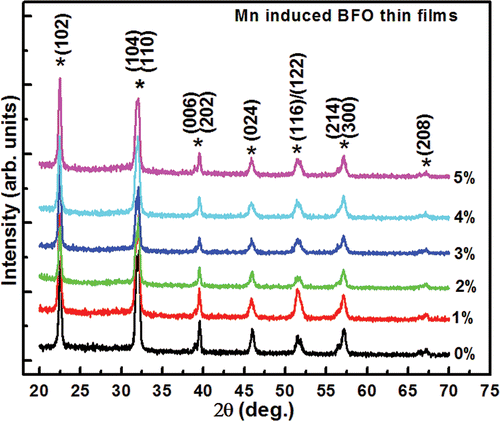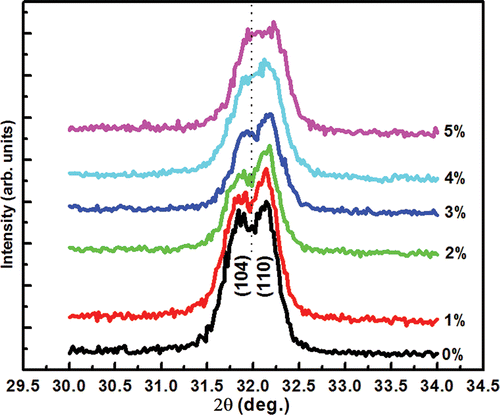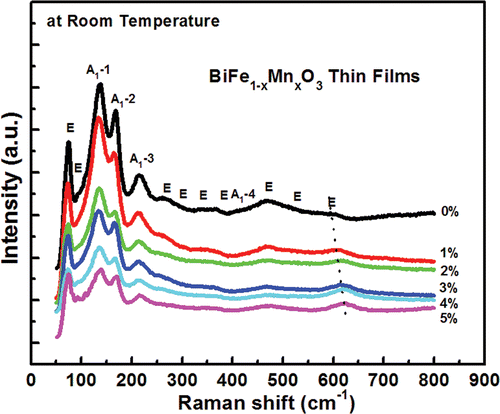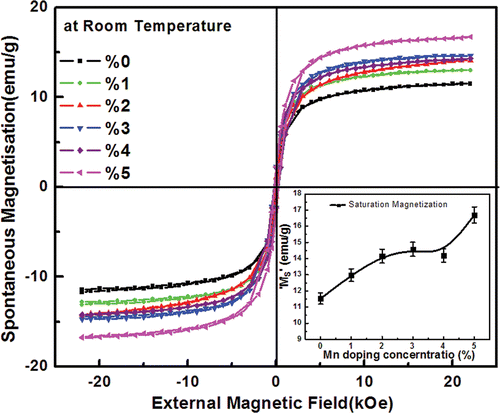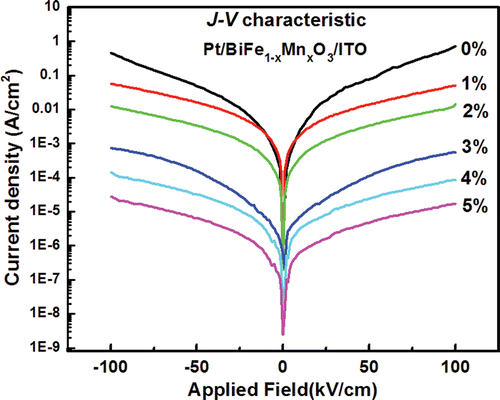Abstract
Enhancement of magnetic and electric properties in multiferroic Mn-substituted BiFeO3 thin films (BiFe1− x Mn x O3 with x = 0.00–0.05) grown via the low-temperature chemical solution deposition process on low-cost substrates like indium tin oxide (ITO)/glass and silicon is reported in this work. A detailed structural analysis by high-resolution X-ray diffraction and Raman spectroscopy indicates that the grown films exhibit rhombohedral distorted perovskite structure without any impure phase. Raman spectroscopic analysis shows all 13 Raman active (4A1 + 9E) phonon modes corresponding to distorted rhombohedral BFO R3c structure. BFO thin film with 5% Mn substitution showed maximum saturation and remnant magnetisation (M s = 16.70 emu/g and M r = 2.58 emu/g) and remarkably reduced leakage current due to distortion in the spin cycloid structure and suppression of oxygen vacancies due to partial replacement of Fe3+ ion by Mn3+ ion, respectively. These enhanced multifunctional properties highlight the potential applications of BFMO system in thin film devices which can couple magnetic and ferroelectric order parameters.
1. Introduction
Among ABO3-type perovskite oxide materials, BiFeO3 (lead free and environmental friendly) is the only single-phased multiferroic material that crystallise in rhomobohedrally distorted structure (space group R3c) and exhibits both ferroelectricity (Curie temperature: T
c ∼ 830°C) and G-type antiferromagnetism (Néel temperature: T
N
∼ 370°C) at room temperature Citation1–3. Due to simultaneous coexistence of ferroelectric, ferromagnetic and ferroelastic phases, multifunctional material bismuth ferrite (BFO) exhibits collective responses to the electric, magnetic field called ME (Magnetoelectric) effect, making it most appropriate for novel applications such as spintronics, multiple state memory, magnetically modulated transducers, magnetic field sensors and ultrafast optoelectronic devices Citation1–3. However, there are serious material-related problems that need to be solved, such as large dielectric loss, high-leakage current, low remnant polarisation, inhomogeneous magnetic spin structure and the presence of secondary parasite phases as Bi has high volatility at high temperature processing Citation3,Citation4. The high-leakage current density in BFO is due to the variable oxidation states of Fe ions (Fe3+and Fe2+) which on interconversion from Fe3+ to Fe2+ create oxygen vacancies following where
is oxygen vacancy and LO is oxygen at a lattice position. According to the Le Chatelier principle, if the content of Fe3+ is reduced, then the concentration of Fe2+will decrease. Hence doping at Fe site would suppress the formation of oxygen vacancies and reduce the concentration of Fe2+, thereby reducing the leakage current Citation5. In this study, the effect of Manganese (3d transition element series adjacent to Fe in periodic table) substitution at Fe sites on structural, electrical and magnetic properties of nanocrystalline BiFe1−
x
Mn
x
O3 (BFMO) thin films (with x = 0.00, 0.01, 0.02, 0.03, 0.04 and 0.05) grown by the low-temperature chemical solution deposition process is reported. Limited work is done in the literature, specially in the Raman scattering spectroscopy study on the Mn-substituted BFO thin films grown on low-cost substrates.
2. Experimental
Pure BFO and 3d transition metal (Mn)-doped BFO thin films were prepared by the chemical solution deposition technique. The precursor solution for depositing the pure BiFeO3 thin film was prepared by homogeneously mixing bismuth (III) nitrate pentahydrate and iron (III) nitrate nanohydrate in stoichiometric ratio (Bi/Fe = 1.05:1) in 2-methoxy ethanol with a suitable stabiliser to compensate high bismuth volatility at higher temperature processing. The various concentrations of Mn were incorporated by adding manganese (II) nitrate to the precursor solution of BiFe1− x Mn x O3 with (x = 0.00, 0.01, 0.02, 0.03, 0.04 and 0.05). Then films of the prepared solutions having different composition were deposited on different substrates (corning glass, ITO/glass and silicon) using a spin coater followed by pyrolysis at 300°C for 5 min to remove all organic solvents. This process was repeated several times to obtain thin film of the required thickness (∼500 nm). These samples were post annealed at 550°C for 1 h in N2 atmosphere. For performing all electrical measurements, circular top platinum electrodes (600 µm) were RF sputtered in 100% argon atmosphere. The crystal structure was investigated using high-resolution X-ray diffraction patterns (Bruker D8 Diffractometer) and optical phonon modes by Raman spectroscopy (Renishaw Raman System). Room-temperature magnetic properties were characterised using a vibrating sample magnetometer (VSM) and the electric measurements (J–V) were carried out using a semiconductor characterisation unit (Keithely 4200).
3. Results and discussion
3.1. Structural analysis
X-ray diffraction patterns of the BiFeO3 and BiFe1− x Mn x O3 (BFMO with x = 0.00, 0.01, 0.02, 0.03, 0.04 and 0.05) films obtained at low grazing angle are shown in . Observed diffraction peaks for BFMO suggest the formation of rhombohedral perovskite structure with a space group R3c and no secondary phases related to manganese oxide are detected, indicating the incorporation of Mn2+ ions at Fe3+ sites. Mn ions are known to take oxidation states from +2 to +4 among which +2 valancy is the most stable. Furthermore, annealing the films in reduced atmosphere of N2 gas would favour the existence of Mn2+ acceptor ions Citation6. However, the presence of other oxidation states of Mn cannot be completely ruled out. In pure BFO thin films, peaks corresponding to (104) and (110) planes are distinctly observed while slight shift and overlap of these peaks is observed for BiFe1− x Mn x O3 thin films , which could be attributed to small distortion in the crystal structure due to lower ionic radii of Mn2+ ions (0.067 nm) which partially substitute Fe3+ ions (0.087 nm) Citation7. As illustrated in , (104) and (110) diffraction peaks of BFMO thin films also gett broadened due to Mn incorporation, i.e. small size effect, indicating that the grain size is decreased by Mn doping with smallest average grain size (∼32 nm) for BiFe0.95Mn0.05O3 thin film calculated using FWHM and the Scherrer formula.
3.2. Raman scattering spectra analysis
In order to determine the symmetry changes of BFO films observed by XRD, room-temperature unpolarised Raman spectra have been obtained in a back-scattering geometry using Renishaw Raman spectrophotometer (naturally polarised Ar+ ion laser, λ = 514.5 nm). Before performing the experiment, it was ensured that laser power does not heat or modify the sample. shows the Raman spectra of BFO and BFMO thin films. Theoretical group analysis has predicted 13 Raman active optical phonons modes summarised as Γ = 4A 1 + 9E for rhombohedral distorted BFO with an R3c structure Citation8–10 and all the modes could be seen in the films deposited in the present case. Raman scattering data clearly shows four intense peaks of high intensity at 71, 136, 165 and 204 cm−1 corresponding to the modes (E-1, A 1-1, A 1-2 and A 1-3) whereas other phonon mode peaks are visible at 107, 254, 286, 341, 366, 433, 478, 546 and 601 cm−1, confirming the structure of BFO thin films. However, the peak intensity is low and peaks are slightly shifted compared to the bulk BFO Citation8. Similar behaviour has also been observed in the chemical solution deposited in pure and doped BFO thin films Citation11. With increasing Mn doping concentrations, the intensities of E-1, A 1-1, A 1-2 and A 1-3 modes decrease and the peaks get broadened related to Bi–O vibrations Citation12. Furthermore, the appearance of strong peaks and shift in the position of E-9 phonon mode (around 600–618 cm−1) and a wide peak around 470 cm−1 is related to stretching and bending of MnO6 octahedera in RMnO3 perovskite, respectively Citation12. These results indicate that Mn is being substituted only at Fe sites in the BiFeO3 lattice.
3.3. Ferromagnetic responses
The magnetic hysteresis (M–H) loop of BiFeO3 and Mn-induced BiFeO3 thin films measured by vibrating sample magnetometer at room temperature are shown in . Pure BFO showed a weak hysteresis loop which improves on Mn substitution, and for the BiFe0.95Mn0.05O3 maximum saturation magnetisation (M s = 16.7 emu/g), as shown in the inset of , and remnant magnetisation (M r = 2.58 emu/g) are observed. The increase in the macroscopic magnetisation of Mn-substituted BFO may be attributed to small grain size of BFMO thin films (32 nm) along with the canting of antiferromagnetically ordered spins by magnetoelectric effect of polarisation and the favourable distortion of the spin cycloid of Fe3+ ion due to the random partial substitution of Mn2+ ions with a different valence and size Citation13,Citation14. The value of magnetisation is found to be much higher compared to the bulk counterpart and is related to the presence of canting effect in BFO thin films, which is otherwise absent in the bulk [13].
3.4. Electrical studies
exhibits the dependence of the leakage current density (J) on the applied electric field (E) for the pure BFO and Mn-doped BFO thin films. It may be seen that the leakage current density is very low for the low-electric field, which increases sharply with increase in the electric field and with further increasing the electric field current density almost saturates. The general behaviour is same for all the films and with increasing the Mn-doping concentration in BFO, the leakage current keeps on decreasing. For the BiFe0.95Mn0.05O3 thin films, a minimum leakage current density of 8.74 × 10−6 A/cm2 is observed at an applied electric field of 74 kV/cm, which is about 5 order of magnitude lower than the current density (1.32 × 10−1 A/cm2) of the pure BFO film. Oxygen vacancies created in pure BFO thin films effectively introduce electrons in lattice and increase the free carrier concentration due to the hopping of electrons from Fe3+ to Fe2+ ions Citation15–17. It can be seen that a small amount of Mn substitution greatly enhances the resistivity of the films and reduces the leakage current density, as shown in , attributed to suppression in oxygen vacancies due to random Mn substitution at Fe sites in BFMO thin films Citation17.
4. Conclusion
In summary, pure BFO and Mn-doped BFO thin films were successfully prepared on low-cost substrates like tin oxide ITO/glass and silicon using a low-temperature chemical solution deposition process. XRD and Raman analyses revealed that the BFMO films showed a polycrystalline perovskite phase. The presence of Mn in BFMO thin films is identified using XRD and Raman analyses and results in the lattice distortion responsible for the improved ferromagnetic properties. Decrease in the leakage current density observed with Mn substitution in BFO thin films is due to the decrease in oxygen vacancies. The results indicate that Mn-doped BFMO samples exhibit improved room-temperature ferromagnetic and electrical properties for magneto-electric devices.
Acknowledgements
S. Gupta is thankful to the University of Delhi for the research fellowship. Authors are thankful to DST (PURSE Grant) for providing the financial support to carry out this work.
References
- Hill , N A . 2000 . Why are there so few magnetic ferroelectrics? . J. Phys. Chem. B , 104 : 6694 – 6709 . doi: 10.1021/jp000114x
- Eerenstein , W , Mathur , N D and Scott , J F . 2006 . Multiferroic and magnetoelectric materials . Nature Rev. , 442 : 759 – 764 . doi: 10.1038/nature05023
- Catalan , G and Scott , J F . 2009 . Physics and application of bismuth ferrite . Adv. Mater. , 21 : 2463 – 2485 . doi: 10.1002/adma.200802849
- Wang , Y and Nan , C W . 2006 . Enhanced ferroelectricity in Ti-doped multiferroic BiFeO3 thin film . Appl. Phys. Lett. , 89 : 052903 doi: 10.1063/1.2222242
- Wu , J and Wang , J . 2010 . Bilayered BiFe0.95Mn0.05O3/Bi0.90La0.10FeO3 thin films with low ferroelectric coericivity and large remanent polarization . J. Am. Ceram. Soc. , 93 ( 8 ) : 2113 – 2116 . doi: 10.1111/j.1551-2916.2010.03661.x
- Wen , Z , Hu , G , Yang , C and Wu , W . 2009 . Effects of annealing process on asymmetries coercivities of Mn-doped BiFeO3 thin films . Appl. Phys. A , 97 : 937 – 941 . doi: 10.1007/s00339-009-5366-0
- Fukumara , H , Matsui , S , Tonari , N , Nakamura , T , Hasuike , N , Nishio , K , Issihiki , T , Harima , H and Kisoda , K . 2009 . Synthesis and characterization of Mn-doped BiFeO3 nanoparticles . Acta Phys. Pol. A , 116 : 47 – 50 .
- Kothari , D , Reddy , V R , Sathe , V G , Gupta , A , Banerjee , A and Awasthi , A M . 2008 . Raman scattering study of polycrystalline magnetoelectric BiFeO3 . J. Magn. Magn. Mater. , 320 : 548 – 552 . doi: 10.1016/j.jmmm.2007.07.016
- Singh , M K , Jang , H M , Ryu , S and Jo , M H . 2006 . Polarized Raman scattering of multiferroic BiFeO3 epitaxial films with rhombohedral R3c symmetry . Appl. Phys. Lett. , 88 : 42907 doi: 10.1063/1.2168038
- Fukumara , H , Harima , H , Kisoda , K , Tamada , M , Noguchi , Y and Miyayama , M . 2007 . Raman scattering study of multiferroic BiFeO3 single crystal . J. Magn. Magn. Mater. , 310 : 367 – 369 . doi: 10.1016/j.jmmm.2006.10.282
- Murari , N M , Thomas , R , Melgarejo , R E , Pavunny , S P and Katiyar , R S . 2009 . Structural, electrical, and magnetic properties of chemical solution deposited BiFe1 − xTixO3 and BiFe0.9Ti0.05Co0.05O3 thin films . J. Appl. Phys. , 106 : 014103 doi: 10.1063/1.3158556
- Do , D , Kim , J W and Kim , S S . 2011 . Effects of Dy and Mn codoping on ferroelectric properties of BiFeO3 thin films . J. Am. Ceram. Soc. , 94 ( 9 ) : 2792 – 2795 . doi: 10.1111/j.1551-2916.2011.04720.x
- Reddy , V R , Kothari , D , Gupta , A and Gupta , S M . 2009 . Study of weak ferromagnetism in polycrystalline multiferroic Eu doped bismuth ferrite . Appl. Phys. Lett. , 94 : 082505 doi: 10.1063/1.3089577
- Lee , D , Kim , M G , Ryu , S , Jang , H M and Lee , S G . 2005 . Epitaxially grown La-modified BiFeO3 magnetoferroelectric thin films . Appl. Phys. Lett. , 86 : 222903 doi: 10.1063/1.1941474
- Basu , S R , Martin , L W , Chu , Y H , Gajek , M , Ramesh , R , Rai , R C , Xu , X and Musfeldt , J L . 2008 . Photoconductivity in BiFeO3 thin films . Appl. Phys. Lett. , 92 : 91905 doi: 10.1063/1.2887908
- Yun , K Y , Noda , M , Okuyama , M , Saeki , H , Tabata , H and Saito , K . 2004 . Structural and multiferroic properties of BiFeO3 thin films at room temperature . J. Appl. Phys. , 96 ( 6 ) : 3399 – 3403 . doi: 10.1063/1.1775045
- M.H. Lee, J.S. Park, D.J. Kim, H.J. Cho, Y.S. Sung, M.-H. Kim, J.H. Cho, H.I. Choi, D. Do, W.-J. Kim, S.S. Kim, B.C. Choi, and T.K. Sung, Ferroelectric properties of Mn-doped BiFeO3 thin films, Curr. Appl. Phys. 11 (2011), pp. 189–192
